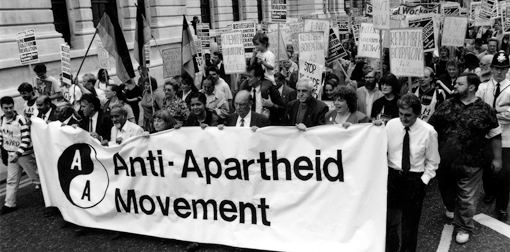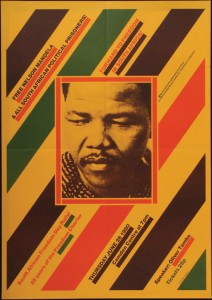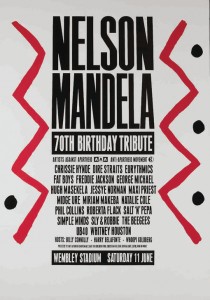Forward to Freedom
The multimedia archives of the Anti-Apartheid Movement are now available online. Christabel Gurney, AAM Archives Committee, provides a tour of this new resource.
About the author: Christabel Gurney was active in the Anti-Apartheid Movement from 1969 to 1994. She edited the AAM’s monthly newspaper Anti-Apartheid News in the 1970s and was later secretary of Notting Hill Anti-Apartheid Group. More recently she has researched and written about the history of the AAM.
Web: www.aamarchives.org
Email: info@aamarchives.org
When the Anti-Apartheid Movement (AAM) dissolved itself – mission accomplished – after the inauguration of Nelson Mandela as South Africa’s President in 1994, it wanted to make its history accessible to future historians and campaigners. Founded as the Boycott Movement in 1959, the AAM campaigned for thirty-five years for the isolation of apartheid South Africa and for support for those fighting against it. It campaigned as well against South Africa’s occupation of Namibia, for independence from colonial rule for Zimbabwe, Mozambique and Angola, and in the 1980s against South Africa’s attacks on its newly independent neighbours. Perhaps surprisingly, for a chronically under-resourced and overstretched pressure group relying largely on volunteers, the AAM had preserved a voluminous quantity of letters, minutes and leaflets. Its records included iconic posters by designers like David King and Ken Sprague, and hundreds of badges, T-shirts, mugs and other campaign ephemera. Unsurprisingly, the material was chaotic and jumbled, much of it mouldering in damp basements and garages.

AAM supporters marched up Whitehall to the South African Embassy to protest against the killing of around 40 township residents at Boipatong on 26 June. They asked the British government to support international monitoring of the violence in South Africa. Among those carrying the banner (l to r) are Peter Hain MP, Billy Nair, Patsy Pillay, Bob Hughes MP, Archbishop Trevor Huddleston and Ken Campbell, General Secretary of the Fire Brigades Union. After the march, Walter Sisulu and Trevor Huddleston led a vigil outside the South African Embassy in memory of those who died. (Date: 1992)
The first step was to conserve and sort this archive. In 1995, a newly formed AAM Archives Committee, made up of AAM Executive Committee members, a historian and a sympathetic archivist, deposited the material at the Library of Commonwealth and African Studies at Rhodes House, part of Oxford’s Bodleian Library. The library raised the funding for a full-time archivist. The connection with Cecil Rhodes, archenemy of African self-determination, was not lost on the Committee, but was accepted in the spirit of reconciliation and the new times. After several years hard work by our committed archivist, Lucy McCann, 800 miscellaneous large cardboard boxes were transformed into around 1,200 archive boxes. This was a rich resource for academic researchers, but only a first stage in making the AAM’s history accessible to people without a Bodleian reader’s card and a taste for delving into archives.
The idea of creating a website was the brainchild of the AAM’s Executive Secretary Mike Terry, whose premature death in 2008 was an irreplaceable loss. Mike was at the centre of the AAM for over twenty years and had a fund of memories and insights. The project had a long gestation, but in the summer of 2012 secured a generous grant of £6,000 from the Barry Amiel & Norman Melburn Trust. It quickly became apparent that to create a website that did justice to the AAM’s rich history and displayed a representative selection of its papers and artefacts would require more funding. At a second attempt, in April 2013 the Archives Committee secured a grant of £38,500 from the Heritage Lottery Fund. The grant was not just for a website but for a wider initiative, including the creation of an oral history archive, learning resources, outreach events and a pop-up exhibition that would outlast the initial year’s activity. The Forward to Freedom project was born.
… video content includes clips from the 1988 and 1990 Wembley rock concerts held as a tribute to Nelson Mandela
With the appointment of Jeff Howarth as Project Manager, the project got underway in June 2013. Jeff had extensive experience with Anti-Slavery International and on the TUC’s ‘Britain at Work’ website and had worked with Archives Committee Secretary Christabel Gurney on the committee’s lottery application. The delivery of the extended project with the available cash in a limited timescale was a challenge, and depended crucially on his expertise and technical resourcefulness and on extensive voluntary work put in by key members of the committee and other volunteers. The project also depended on cooperation with Action for Southern Africa (ACTSA), the AAM’s successor organisation, which contributed office space and employment services.

Poster advertising a rally on South Africa Freedom Day, 26 June, to mark the 25th anniversary of the Freedom Charter. The rally was organised by an umbrella group, the South Africa Freedom Day Committee, and the main speaker was ANC Secretary-General Alfred Nzo. The ANC declared 1980 the ‘Year of the Charter’ and the AAM distributed thousands of copies of the Freedom Charter during the year. (Date: 1980 Design: David King. South Africa Freedom Day Committee)
The website was created as a multi-layered resource that is accessible to everyone interested in the history of political and human rights campaigning, gives an introduction to the archive for academic researchers and provides a show-case of photographs and graphic material for those looking for illustrations for publications and exhibitions. Twenty-four web pages provide brief introductions to anti-apartheid action in each decade, to campaigns on issues like the arms embargo, sport and political prisoners, and to the involvement of interest groups such as trade unions, faith groups and black solidarity organisations. Attached to each page is a selection of posters, leaflets and other campaign materials. Under the menu heading ‘Government’ are a sample of the hundreds of letters and memoranda that the AAM sent to successive Labour and Conservative governments over the decades.
Video content includes clips from the 1988 and 1990 Wembley rock concerts held as a tribute to Nelson Mandela and broadcast worldwide by the BBC, and the Hyde Park rally that brought together a quarter of a million people calling for Mandela’s release on the eve of his 70th birthday. The site also features video of Jerry Dammers hit song ‘Free Nelson Mandela’ and excerpts from interviews for Connie Field’s groundbreaking film series ‘Have You Heard from Johannesburg?’. The site was built using freeware Joomla CMS and uses Phoca image gallery software to contain the digital archive.
The Archives Committee was concerned not to infringe copyrights: it holds the copyright to all material produced by the AAM and it sought permission from photographers to display low resolution images of prints held in the archive. Where the copyright holder is known, anyone who wants to reproduce an image is asked to submit a request via the website.

Poster advertising the concert held at Wembley Stadium on 11 June 1988 as part of the AAM’s ‘Nelson Mandela: Freedom at 70’ campaign. The poster was one of six specially commissioned from leading graphic artists. The concert was attended by a capacity audience of 72,000 and broadcast to 63 countries with a potential audience of a billion people. Oliver Tambo was the guest of honour and Stevie Wonder, Whitney and Sting were among the performers. (Date: 1988 Anti-Apartheid Movement)
The project created an oral history archive to add a new dimension to the written records. Volunteers conducted 41 new interviews, and clips and transcripts of these were uploaded onto the website. The Museum of London helped in the digitisation of earlier taped interviews; some of them conducted in 2000 by Swedish sociologist Håkan Thörn for his book ‘Anti-Apartheid and the Emergence of a Global Civil Society’. Interviewees include key AAM staff members like Mike Terry and Ethel de Keyser, leading trade unionists like Jack Jones and Ron Todd, founders of partner organisations such as End Loans to Southern Africa’s Rev David Haslam and grassroots activists from former anti-apartheid local groups, recounting the experiences of some of the hundreds of thousands of people who took part in anti-apartheid campaigns.
Another part of the project was the creation of a twenty-two-board pop-up exhibition, available for loan to schools, colleges, libraries and community organisations. This went on display for the first time at a very successful project launch at the South African High Commission in March 2014 and has since been shown at TUC Congress House, Unison’s new headquarters building and at conferences in London and Oxford. During Black History Month 2014 in October it will go on show in Islington, Camden and Norwich.
Project learning resources so far consist of an online education pack designed for the Key Stage 3 citizenship curriculum. It is planned to pilot this in schools in the autumn term. We are keen to work with educators in other curriculum areas and other settings like adult education and trade union courses to draw on the website to create more learning resources.
One of the key issues facing any project like ours is how to make it sustainable and on-going when the initial cash resources have run out and the project manager moves on. The Forward to Freedom project has left the AAM Archives Committee reinvigorated by the enthusiasm of a new generation of activists keen to use the experience of the past to inform the campaigns of the future. Having traversed a steep learning curve and with volunteer support, we plan to maintain and add to the website for an initial ten-year period and to build on the Key Stage 3 education pack to create new educational materials.
Christabel Gurney

 Learning on Screen
Learning on Screen